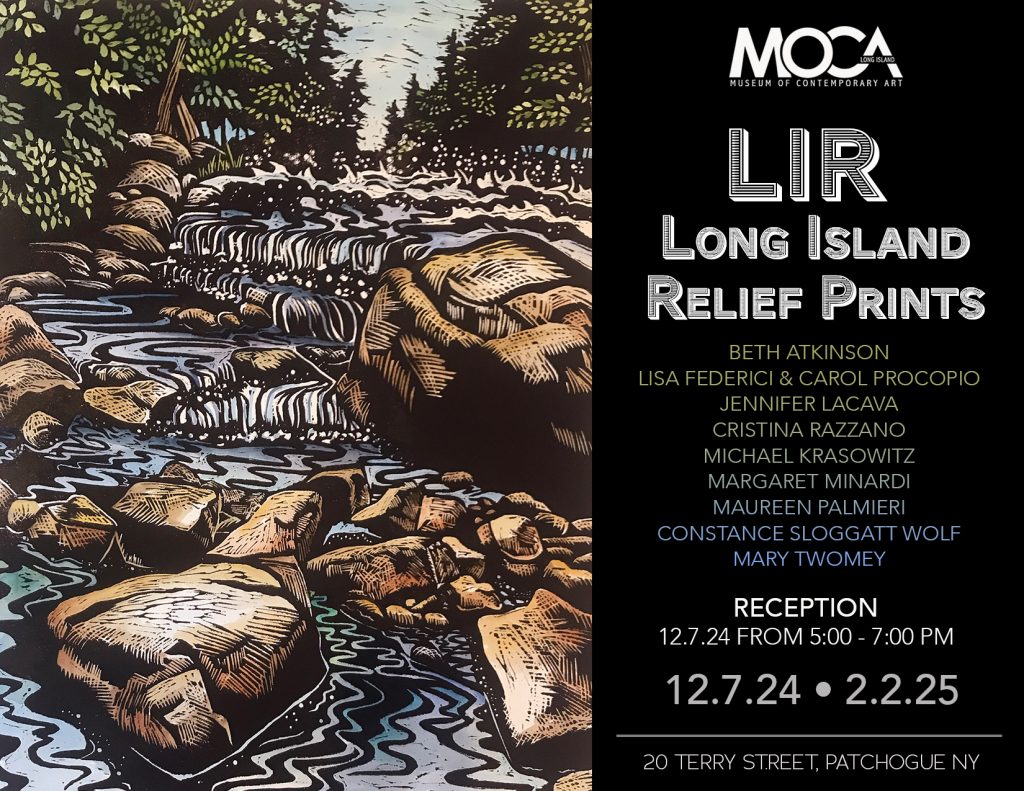
Long Island Relief Prints
L.I.R.
Curated by John Cino
December 7, 2024 – February 2, 2025
Reception Decmber 7 from 5:00 – 7:00 PM
Printmaking, considered an indirect process, describes a variety of techniques in which artists create imagery on one surface and transfer that image onto a second. Often the process allows for multiple prints to be pulled from a single surface or matrix. The various processes are divided into four main groups: relief, printing from a raised surface; intaglio, printing from recesses in the matrix; planography which uses resist (incompatibility of oil and water) and serigraphy (forcing ink through a screen or stencil). Each group may be subdivided based on the material used and techniques applied to the matrix. Most of the groups and subgroups are practiced by Long Island artists who often use multiple techniques. However there are few artists who address the laborious process of relief printing.
Relief prints usually begin with a matrix of wood or linoleum which is carved with a gouge. Ink (traditionally black) is then rolled onto the uncut areas. Paper is then laid across the matrix. Pressure is applied either through a press or by rubbing and the ink is transferred onto the paper. Areas of the matrix uncut will accept ink and therefore print black, while areas that are cut away will leave exposed paper. While black on white is the most traditional color choice, the single ‘pull’ technique can allow for a variety of colored inks and papers.
There has been a renewed interest in relief printing with the arrival of ‘Big Ink’ on Long Island. ‘Big Ink’ led by Lyell Castonguay offers the opportunity for artists who would otherwise have no access to create large scale relief prints. ‘Big Ink’ travels throughout the country and has visited Long Island three times (and will return in October 2025). The prints by Lisa Federici & Carol Procopio, Jennifer LaCava, Margaret Minardi and Maureen Palmieri were created on ‘Big Ink’s’ press.
Michael Krasowitz’ multi-color biomorphic prints (Chariots of the Gods and High Tower) were created by the reduction method. In a reduction print the matrix is minimally carved and printed, creating broad areas of color. The artist returns to the carving process removing areas of color and the paper is reprinted. The process may continue adding more colors onto the final print. Michael’s fluid forms are accentuated by this multi-color process.
Color and fluidity are also on display in Mary Twomey’s prints (Eddy, Meditation 2 &3). Twomey’s linocuts are layered over monotypes. A monotype is created by painting in oil washes onto a plastic matrix and transferring onto final print paper. The monotypes lend an extra layer of shimmering translucence under her turbulent wave forms.
Water plays a role in the landscape prints of Beth Atkinson. She hand colors Virgin River and Buttermilk Falls creating a dazzling display of light and water. These prints could almost be called impressionist except for the rich blacks of the wood cut. Atkinson’s Katerskill Falls is the largest print in the exhibit (kudos to Big Ink). The falls connects sky to river in a glorious 96 by 30 inch print allowing Atkinson to show off her rich vocabulary of natural forms.
Natural forms are also the hallmark of Constance Sloggatt Wolf who pushes her black and white nature studies to the edge of abstraction (Genome Hosta). Sloggatt Wolf fills her entire compositions in graceful movement, separating rich black tones with strong linear elements, rhythmic patterns, and areas of texture (Divine Dance). Her Milkweed is a close second to Katerskill Falls in monumentality although in Sloggatt Wolf’s work it is the mundane that is monumentalized.
Cristina Razzano recalls a domestic warmth as her still life objects are surrounded by patterns derived from traditional quilts (Girasol, Still Life). In Great Blue Heron the majestic bird is not only surrounded by her ever present patterning, the image is directly printed on an antique quilt. Razzano’s work reminds us that there is much to be gained from recalling past tradition.
Relief printing is an ancient tradition, the first wood block prints were made in China over 1000 years ago. Even as many artists seek to work in new contemporary ways we can find others that mine older techniques to create unique and personal art as do the artists of LIR, Long Island Relief.
– John Cino, curator, November 2024
Learning to Look | Printmaking
November 20 from 6:30 – 7:30 PM
In person and on Zoom Meeting ID: 880 1524 8901 | Passcode: 419010
Coffee with a Curator
January 18, 2025 @ 12:00 NOON
In person and on Zoom Meeting ID: 873 0499 3359 | Passcode: 962774
Linocut printing with artist Filiberto Perez
January 11 & 25 from 12 NOON – 3:00 PM
Register info@patchoguearts.org
Most supplies provided | $30 per person for both sessions (must take both sessions)